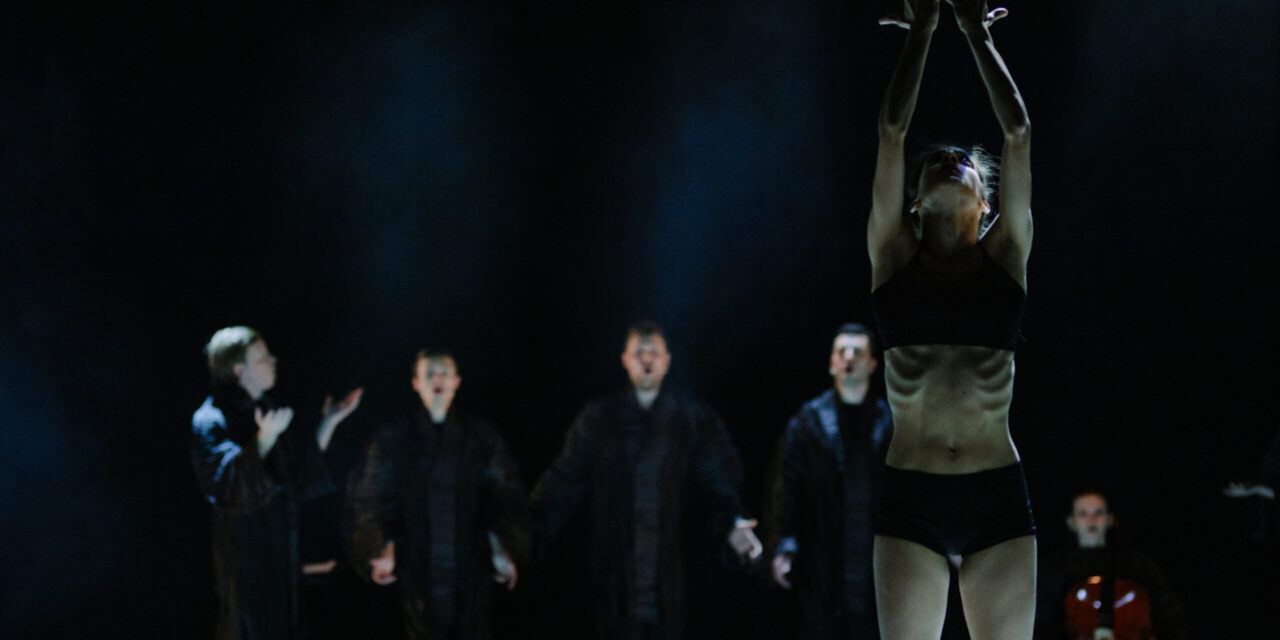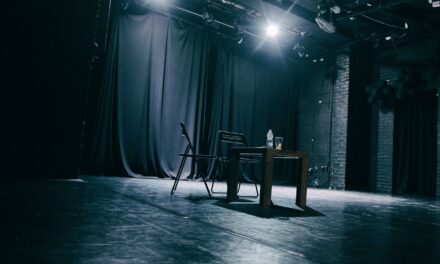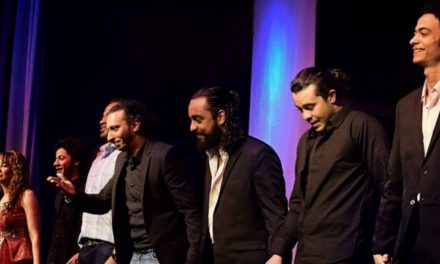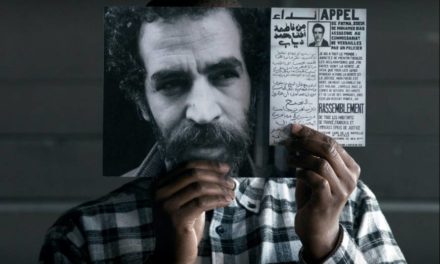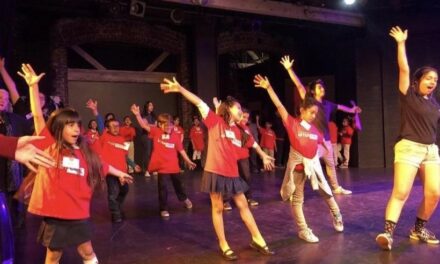Song of the Goat Theatre was founded in 1996 by Grzegorz Bral and Anna Zubrzycki, and is now led by the former, in Wrocław, Poland. The cosmopolitan nature of the physically and vocally-based company was further explored in the production of Anty-Gone that premiered on November 22, 2018. Inspired by Sophocles’ tragedy, this monumental performance lasted over three hours and consisted of three acts: Seven Gates of Thebes, Anty-Gone, and Ecstasy. In April 2019, Anty-Gone concluded – to enormous applause from the audience – the Grotowski Fest in Warsaw, which was a global celebration of the twentieth anniversary of Jerzy Grotowski’s death. Melanie Lomoff, an independent choreographer and dancer from France, describes her collaboration with Grzegorz Bral to Tomasz Wiśniewski.
Tomasz Wiśniewski: When did you come across the work of Grzegorz Bral?
Melanie Lomoff: Grzegorz invited me to the Brave Festival twice, in 2014 and 2018, and this is how I discovered his work. I then taught at the London University of Performing Arts, at the Ballet Institute, for one season.
TW: Yesterday we watched the premiere of Anty-Gone, which resulted from your collaboration with Song of the Goat Theatre as a choreographer. You were responsible for the group of dancers. How did you cast your ensemble?
ML: Grzegorz announced an open call and we organized an audition for forty dancers that were selected on the basis of their submitted CVs and videos. The audition took place in July 2018 in Wrocław. Then we decided on the twelve performers we wanted to work with.
TW: It is striking that the dancers come from various training traditions, so each has a distinctive movement style that significantly differs from the other dancers. Was the process of creating an ensemble out of such strong, artistic individuals a challenge for you?
ML: At the beginning, it does not seem an easy task, but the best performers should be able to form a collective after a while. Otherwise, something is missing in their skill set. Additionally in this project, there is a connection between the dancers and the singers. Beauty is created by their mutual interaction. Before the project began, I talked to Grzegorz a lot about the collective nature of our work. With the prominence of the music, it has made more and more sense to work as the whole group.
TW: But in the beginning, you worked without the singers in order to develop the team of dancers’ strength.
ML: Yes, the dancers and the singers started their work separately.
TW: How did you develop the gestural language and overall choreography? To what degree did inspiration come from music? How much was it determined by the language? And to what degree has your choreography come from people you have worked with?
ML: All of the ingredients you have enumerated are important to me. Music inspired me a lot, but words did as well. Then, the physicality of the dancers was very important. All these elements gave me inspiration to create movement. Because I am not used to working in this way, it was a very intense experience. Anty-Gone is a performance, but it is not a dance piece. The music was written before we started dance rehearsals so even at that early stage we needed to bear in mind it was an important part of the stage universe. For this reason, creating and practicing choreography was very interesting. Happy as I am to have experienced the process, it was a challenge for me. In other projects, once the theme is established, I follow my intuition and inspiration when working independently. This time, I was neither alone nor was I the director. Apart from my ideas, there were external ingredients that I had to take into consideration. This kind of creative work was certainly new to me.
TW: In the last week of rehearsals, there appeared moments of synergy between the actors and dancers. I remember you asking your dancers whether they observed the vocal quality the singers achieved. They agreed the song and the melody was particularly inspiring at this time. How often have you experienced such synergy in practice?
ML: These are magical moments. You can rehearse for long hours and days, but sometimes there are also scenes that turn into – as you are saying – moments of synergy. You cannot really plan them or press a button to make them happen. You really cannot explain why they are happening at that particular moment. I am convinced that when devising Anty-Gone we made use of such moments so as to develop an increasingly coherent performance. The dancers and the singers felt they were more and more united. I would go as far as to say this piece has got enormous potential to develop even further beyond what we watched yesterday.
TW: But even at this stage, the show had established a powerful structure and the performers achieved intense interactions. What about the change from the cameral space in which you rehearsed to the large stage of the theatre? This shift must have been particularly important to the dancers. Besides, the light design introduced additional parameters to their movement. Do you find working in a new space a challenge?
ML: Challenge is a big word, and adapting to the new space is simply what we have to deal with. Grzegorz said something really interesting today: “Try to be confident, more confident on stage.” Because I am a dancer, I know exactly what is going on on-stage when watching my performers. I know when they struggle with the floor, or with the light, or when something goes wrong. I feel all of that. The conditions are never ideal. You always have to deal with light and throughout my entire dancing career, I have always struggled with light. In Anty-Gone the floor is white, which means that the problem with light is even worse. They are completely blind when they go backstage. I’ve assured my dancers I know exactly what they are going through. The floor is a nightmare, as it is additionally so bright that they cannot really see. I even went to buy special talc so they could be more confident on the stage. They have to deal with this inconvenience throughout the entire performance, so I had to adapt with them, and there is not much time to adapt to these new conditions. It is part of a job. We have to adapt. So even if the light would be different, even if the floor would be different, there would be something else to adapt to. From my experience I know it is always like that; in each project, you can say the conditions are not ideal. But like in life, you have to be flexible.
TW: Your dancers frequently work horizontally in groups. At times they move downwards and work on the floor with marked physicality of nearly-gymnastic strength. Some of their formations are repeated several times. Can you reveal some of your choreographic intentions?
ML: I had different kinds of inspiration. Grzegorz tried to explain what sort of dance he is fond of and what sort of movement he is interested in. He showed me a lot of pictures, photographs, and some dance videos. I tried to meet all this with my own dance style, which is rooted in ballet and filtered through contemporary dance theatre, so there is a mix of all of that. As a choreographer, I am increasingly interested in movement that is not necessarily determined by ballet conventions but aims at some kind of precision. After my journey through my career as a dancer, I am coming back to the source. It is vital to me to achieve not only clarity of the body, but also clarity in the language of the body.
It is not my intention to present violent movement because it would not really reflect my inner style. It is not my type of dance at all so that is why you do not see it in the performance. Perhaps it is one of the reasons Grzegorz invited me to cooperate with him? He was well aware of what he wanted to achieve and he knew what to expect from me.
TW: Tell me a bit about your artistic background.
ML: I was trained in ballet, then had an invitation to join a ballet group, but I decided to have a go with African and hip-hop dancers. This was very inspiring because I had a chance to learn a new world after I worked with Alain Platel, who is an amazing director and human being. After touring around the world with this company for seventeen years, I decided again to change my career. I concentrated on developing a more personal body language, and for this reason sought inspiration in reading, painting, listening to music, and other sources. At one point, I realized that what I want to develop is inside me. With this in mind, I started dancing and arrived where I am now.
TW: Anty-Gone consists of three parts. In the first part, called Seven Gates of Thebes, there are no dancers and the story develops verbally and vocally. In the second part – “Anty-Gone” – synchrony between the singers and the dancers is established, and the balance between the two is maintained. But in the third part – Ecstasy – the dancers take the lead, and their on-stage presence is crucial for the stage language. A certain physical conciseness seems to characterize this final and shortest part, in which the visual expression of a pulse – of a heartbeat – is of the greatest prominence.
ML: I think I do not see the performance in this way because it is really recent. I really focus on choreographic art. I did not ask myself a question like that; I did not notice that but it is an idea I came across before.
When Grzegorz told me about Ecstasy, I thought about the hand gesture you allude to because I really like the work of the hands, and for me, in some scenes, it seems like the heartbeat but also like asking for help. It seems to hint at these two possibilities.
TW: The structure of the third part is based on a sequence of movement, singing, then speaking, then movement again. In some episodes, your dancers echo the image set in the first part where the performers used drumsticks as if they were playing air drums. It is a wonderful story when you link these images since they bring together distant parts of the performance.
ML: That’s nice! In the third part, we link the story of Antigone with the body of Chiara. All the other elements are, at this point, more in the body than elsewhere.
TW: In the second part, it seems to me, despite all the interaction, synergy and physicality, the movement of the dancers is more ornamental.
ML: I would not agree it is ornamental in the sense that it is in opera. Even though it is not a dance piece, the movement is not marginal here. The sound and the dance are linked together. Grzegorz’s singers, and the music composed by Maciek Rychły, are prominent so therefore it is difficult not to dance on the beat or to choreograph dance on it. I am very happy with what we achieved at this stage, but there is still room for improvement.
TW: So you are constantly thinking about improvement?
ML: It is because this performance has so many dimensions – in terms of volume, in terms of power, and in terms of precision and digging. On the one hand, Maciej Rychły knows precisely how to express the feelings he wants to through music, and how to transmit these feelings to an audience. On the other hand, Grzegorz Bral has got incredible power to direct people – he knows precisely what to tell each performer so as to achieve his aims.
When speaking about my part, I would say that rather than facing challenges, I am digging so as to discover how to transform existing details into more beautiful ones. I want to make them brighter and better.
TW: Are there any scenes in the performance where you are surprised by the outcome?
ML: I find all of the parts beautiful and I like to see all the dancers, hopefully not just because it is my choreography. It is intriguing to see the scenes when the beginnings of a language are developing. But I am conscious the process has not finished, and I see huge potential in the whole thing. It is difficult for me to speak of choreography, but I have my favorite musical parts. Some of the music that gives me shivers and inspires me is about missing someone a lot. Sometimes the music breaks my heart but in a good way.
My touring experience suggests the first performance is never complete, or we would quickly get bored. But I am really satisfied with what we have. Yesterday I was really excited and really happy.
TW: How much is your choreography changing at this stage?
ML: At the moment, I cannot put my dancers in a difficult situation so it is quite steady. We need to remember we have only two performances, but even within the last week, it was quite dynamic. But I can see where the project may go if we continue working. I think the project should be like this, and I am still digging. Let me compare my situation to that of a painter who one day has to say, “Okay, I am looking here, I am looking there, and it is finished.” But with dance, it is alive forever. Even when I feel that the shape of my choreography is complete, there still remain things for the dancer to inject to keep the performance alive.
TW: That is what performative art is about – keeping the performance alive.
ML: When you have done the same performance two hundred times, you have to find a way to keep it alive. My experience suggests that you do not have to renew it, but to keep searching, to keep digging.
TW: Were there any surprises within the process? Was there anything you completely did not expect?
ML: To be frank, at the beginning I had no expectations whatsoever. I began with a blank canvas because I loved Grzegorz’ work so much and I knew the dancers. The only thing I was sure about was that I would dive into a different artistic world than mine so I was prepared to be very flexible, open and ready for any possibility. Some choreography was established quite quickly. In some cases I linked it with music; in others, it was Grzegorz who surprised me with immediate and appropriate decisions. These moments were magical and surprised me a lot.
TW: Did your dancers have many opportunities to improvise?
ML: Not really. It is powerful when dancers do not improvise because as performers, they should have a language. In my opinion, when dancers improvise they miss the language. I like when dancers know what they are doing because if we are to perform twice and improvise for both evenings, one is going to be great and the other is going to be much less great. The whole performance requires a structure that creates an appropriate feeling for both the story and the emotions and is not about their own interpretation. Of course, at the beginning, I gave them some freedom in order to see what they have to offer.
TW: In general, is your work based in France nowadays?
ML: Nowhere specifically. I am French and I live in Paris. This year I am going to work a little bit more in Paris, but I refuse to have my own company because I do not want to do administration. I would have to spend most of my life on it. I prefer to take the opportunities that life offers to me.
Transcription by Anna Głuszek
This post was written by the author in their personal capacity.The opinions expressed in this article are the author’s own and do not reflect the view of The Theatre Times, their staff or collaborators.
This post was written by Tomasz Wiśniewski.
The views expressed here belong to the author and do not necessarily reflect our views and opinions.

